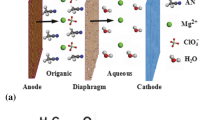Abstract
A novel type of magnesium-air primary cell has been evolved which employs non-polluting and abundantly available materials. The cell is based on the scheme Mg/Mg(NO3)2, NaNO2, H2O/O2(C). The magnesium anode utilization is about 90% at a current density of 20 mA cm−2. The anode has been shown to exhibit a low open-circuit corrosion, a relatively uniform pattern of corrosion and a low negative difference effect in the electrolyte developed above as compared to the conventional halide or perchlorate electrolytes. In the usual air-depolarized mode of operation, the cell has been found to be capable of continuous discharge over several months at a constant cell voltage of about 1 V and a current density of 1 mA cm−2 at the cathode. The long service-life capability arises from the formation of a protective film on the porous carbon cathode and fast sedimentation of the anodic product (magnesium hydroxide) in the electrolyte. The cell has a shelf-life in the activated state of about a year due to the low open-circuit corrosion of the anode. These favourable features suggest the practical feasibility of developing economical, long-life, non-reserve magnesium-air cells for diverse applications using magnesium anodes with a high surface area and porous carbon-air electrodes.
Similar content being viewed by others
References
T. D. Schlabach,Bell Laboratories Record October (1972) p. 283.
C. B. Reed, ‘Fuels, Minerals and Human Survival’, Ann Arbor Science Publishers, Ann Arbor, Michigan, USA (1975) p. 168.
A. Charkey and G. A. Dalin,Proc. 20th Annual Power Sources Conf. The PSC Publications Committee, Red Bank, New Jersey, USA (1966) p. 79.
C. E. Kent and W. N. Carson, Jr.,ibid (1966) p. 76.
C. E. Kent,Proc. 21st Annual Power Sources Conf. The PSC Publications Committee, Red Bank, New Jersey, USA (1967) p. 106.
P. J. Moran (General Electric Co., USA), US Patent 3607 422. (SeeChem. Abst. 147175t 75 (1971).)
H. G. E. Wilson (Shell OU Co., UK), British Patent 1284 738. (SeeChem. Abst. 23279x 78 (1973).)
K. V. Kordesch (Union Carbide Co., USA) US Patent 3783 026. (SeeChem. Abst. 71885a 81 (1974).)
R. W. MacCarthy, US Patent 3825 445. (SeeChem. Abst. 33275q 82 (1975).)
J. Przyluski and E. Palka,Electrochim. Acta 15 (1970) 853.
M. B. Clark, ‘The Mechanism of Magnesium Corrosion’,146th Electrochemical Society Meeting, New York, October (1974) (Abstract No. 2).
Author information
Authors and Affiliations
Rights and permissions
About this article
Cite this article
Sathyanarayana, S., Munichandraiah, N. A new magnesium — air cell for long-life applications. J Appl Electrochem 11, 33–39 (1981). https://doi.org/10.1007/BF00615319
Received:
Issue Date:
DOI: https://doi.org/10.1007/BF00615319




